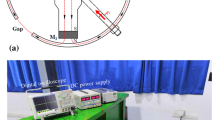Abstract
This paper introduces the development of the caliper system for a geometry PIG (Pipeline Inspection Gauge). The objective of the caliper system is to detect and measure dents, wrinkles, and ovalities affect the pipe structural integrity. The developed caliper system consists of a finger arm, an anisotropic permanent magnet, a back yoke, pins, pinholes and a linear hall effect sensor. The angle displacement of the finger arm is measured by the change of the magnetic field in sensing module. Therefore the sensitivity of the caliper system mainly depends on the magnitude of the magnetic field inside the sensing module. In this research, the ring shaped anisotropic permanent magnet and linear hall effect sensors were used to produce and measure the magnetic field. The structure of the permanent magnet, the back yoke and pinhole positions were optimized that the magnitude of the magnetic field range between a high of 0.1020 Tesla and a low of zero by using three dimensional nonlinear finite element methods. A simulator was fabricated to prove the effectiveness of the developed caliper system and the computational scheme using the finite element method. The experimental results show that the developed caliper system is quite efficient for the geometry PIG with good performance.
Similar content being viewed by others
Abbreviations
- A :
-
Magnetic vector potential [wb/m]
- Hmax :
-
Maximum of magnetic field intensity in inside of magnet [A/m]
- M :
-
Magnetization [A/m]
- L :
-
Length of finger arm [mm]
- D :
-
Radius of wheel [m]
- S d :
-
Size of dent [mm]
- J :
-
Current density [A/m2]
- μ o :
-
Permeability at vacuum [wb/Am]
- ϰ :
-
Susceptibility [A/m]
References
Cordell. J. and Vanzant, H., 1999,All About Pigging, On-Stream Systems Ltd and Hershel Vanzant & Associates.
Crouch, A. E., 1993, “In-Line Inspection of Natural Gas Pipelines,”Gas Research Institute Topical Report GRI 91/0365, pp. 12-16.
Kim, D. K., Cho, S. H., Park, S. S., Yoo, H. R. and Rho, Y. W., 2003, “Design and Implementation of 30" Geometry PIG,”KSME International Journal, Vol. 17, No. 5, pp. 629–636.
Park, G. S., Chang. P. W. and Kim, Y. K.. 2000, “Sensitive Detection of the Defect Signals in MFL Type NDT,”Proceedings of the Ninths Biennial IEEE Conference on Electromagnetic Field Computation, pp. 181, Milwaukee, U.S.A.
Park, G. S., Chang, P. W. and Rho, Y. W., 2001, “Optimum Design of the Non-Destructive Testing System to Maximize the Magnetic Flux Leakages,”Journal of Magnetics, Vol. 6, No. 1, pp. 31–35.
Park, G. S., Hahn, S. Y., Lee, K. S. and Jung, H. K., 1993, “Implementation of Hysteresis Characteristics using Preisach Model with M-B Variables,”IEEE Trans. Magn., Vol. 29, No. 2, pp. 1542–1545.
Tiratsoo, J. N. H., 1992.Pipeline Pigging Technology 2nd Edition Nayler The Printer Ltd, Accrington, UK.
Todd, R. P., Ernst, H. K. and Ron, L. W., 1990, “Pipeline Geometry Pigging: Application of Strapdown INS,”IEEE Journal, CH2811-88, pp. 353–358.
Author information
Authors and Affiliations
Corresponding author
Rights and permissions
About this article
Cite this article
Kim, D.K., Cho, S.H., Park, S.S. et al. Development of the caliper system for a geometry pig based on magnetic field analysis. KSME International Journal 17, 1835–1843 (2003). https://doi.org/10.1007/BF02982422
Received:
Revised:
Published:
Issue Date:
DOI: https://doi.org/10.1007/BF02982422




